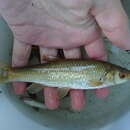Diagnostic Description
provided by Fishbase
Mouth subterminal, snout rounded; head length about equal to maximum body depth; infraorbitals 4 and 5 expanded; communication preopercular-mandibular and infraorbital canals present; supraethmoid narrow and short (Ref. 28035). Diagnosed from its congeners in Iberian Peninsula by the following characters: scales on lateral line 39-44 + 2-3; 3-4½ scale rows between lateral line and pelvic fin origin; infraorbital bones narrow, width of infraorbitals 2 and 5 about 2 times width of sensory canal on same bones; snout rounded, mouth subterminal; and head length about equal to body depth (Ref. 59043).
Life Cycle
provided by Fishbase
Interspecific hybridization occurs between males of L. carolitertii and females of L. alburnoides.
Morphology
provided by Fishbase
Dorsal spines (total): 3; Dorsal soft rays (total): 7 - 9; Analspines: 3; Analsoft rays: 6 - 9; Vertebrae: 39 - 41
Biology
provided by Fishbase
Inhabits from hill streams to middle stretches of rivers (Ref. 59043). Occurs in rivers on the low plains and at high attitudes. Can withstand low levels of oxygen during summer. Juveniles are omnivorous whereas adults feed on arthropods and other animals (Ref. 35754). Reported to feed on fry of other fish species. Involved in the Iberocypris alburnoides hybrid complex (Ref. 59043). Threatened due to habitat destruction, pollution and the introduction of other species (Ref. 26100).
Importance
provided by Fishbase
fisheries: of no interest

